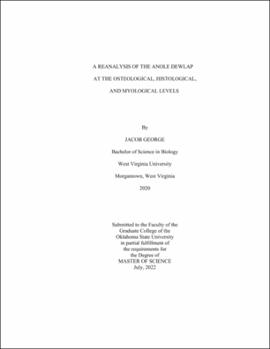| dc.description.abstract | A grounded understanding of the functional morphology of anatomical structures is essential to interpreting the observed dynamics of an organism’s ecology. Anoles (Dactyloidae; Anolis) comprise a diverse grouping of small, arboreal lizards, constituting hundreds of species. The ecological literature on Anoles is robust, particularly surrounding their dewlaps: an elastic tissue fold which can be protruded into by the hyoid bones, which is used in a both inter-and intraspecific interactions. This robustness of understanding ecological implications of the structure, however, is not paired with a robust understanding of the functional morphology of the dewlap, with centuries worth of analysis yet to yield a uniform conclusion. The goal of this study was to use modern digital and microanatomical methods to refine conclusions on the form and function of the anole dewlap. Firstly, I used diceCT (diffusible iodine-based contrast-enhanced computed tomography) protocols, paired with digital dissection in Avizo Lite 2021 to observe the small and delicate musculature attaching to the hyoid apparatus of Anolis carolinensis in both extended and relaxed positions to gain insight into the mechanism of action of dewlap extension. This analysis, while negating certain muscles from consideration of the extension mechanism, also implicated previously absolved muscles, while also revealing a potential new model of dewlap action. Secondly, I analyzed the anole hyoid apparatus histologically, including the application of Toluidine Blue staining protocols. These results, while solidifying the conclusions of previous research regarding the cartilaginous composition of the anole hyoid apparatus, also provided novel observations of fibrocartilage in the anole hyoid apparatus, as well as a potentially novel observed interaction between muscle and cartilage. A potential limitation of these analyses is the small sample size (n=8). Overall, these results provide the groundwork for expanded analysis of anole dewlap form and function, as well as the usage of Anolis as a model system for research on functional implications of unique structures in for the morphology, performance, fitness paradigm in extant and deep time contexts. | |
